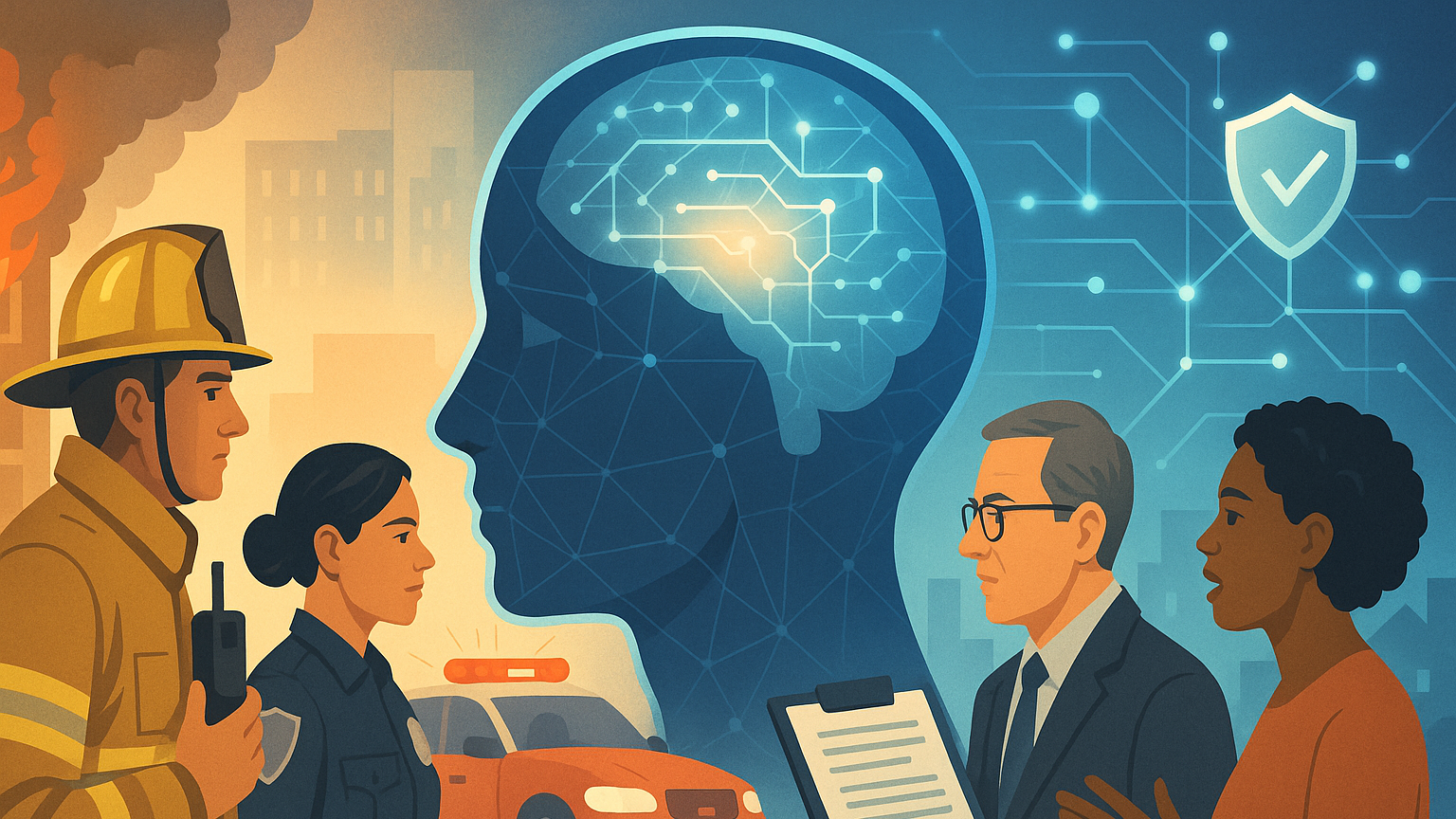
AI Awareness for Public Safety Coordination and Regulatory Stakeholder Management
You work in an environment where public safety, regulatory obligations, and stakeholder expectations intersect in complex ways. This article helps you understand how AI is reshaping the way public safety coordination and regulatory stakeholder management function within organizations and across government and community partners. You’ll find practical explanations, strategic guidance, and actionable considerations so you can make informed choices about adopting AI tools, engaging regulators, and coordinating multi-agency responses without losing sight of legal, ethical, and operational realities.
Why AI Awareness Matters in Public Safety Coordination
You need AI awareness because decisions about technology adoption will affect how effectively you coordinate with first responders, regulators, and community stakeholders. The landscape is changing rapidly. AI is transforming public safety: Moving from incident response to preemptive deterrence, AI can now detect and address threats like wildfires, crime, and traffic risks in real time or even proactively. Understanding these capabilities helps you make strategic choices about resource allocation, training priorities, and regulatory compliance.
The stakes are high. Post-pandemic labor shortages have hit emergency services particularly hard, with 911 dispatch centers reporting vacancy rates exceeding 25% in many metropolitan areas. At the same time, citizens accustomed to real-time ride-share updates and instant package tracking now expect similar responsiveness from emergency services. AI awareness helps you bridge this gap between rising expectations and constrained resources.
Core AI Capabilities Relevant to Public Safety

AI provides several capabilities that are particularly relevant to public safety coordination and regulatory stakeholder management. AI-powered Geographic Information System (GIS) tools analyze satellite imagery, social media, and sensor data to generate immediate impact assessments while AI systems can prioritize calls based on the severity and urgency detected in the voice patterns and keywords.
Real-Time Data Integration and Analysis
Modern emergency management requires processing information from multiple sources simultaneously. AI enhances logistical coordination by ensuring the right resources are deployed efficiently. During an emergency, responders need to move personnel, medical supplies, and equipment to affected areas as quickly as possible. Machine learning algorithms can correlate weather data, traffic patterns, resource availability, and historical incident data to provide actionable insights within minutes rather than hours.
Predictive Analytics for Resource Planning
Studies have shown that AIs are able to learn from complex urban geography, predicting the next day demand for emergency services, so staffing and other preparations could be made easier. This capability transforms how you plan shifts, pre-position resources, and coordinate with partner agencies. Instead of reactive deployment based on calls received, you can proactively position assets where they’re most likely to be needed.
Enhanced Multi-Agency Communication
AI also plays a significant role in facilitating better coordination among different emergency response agencies. By integrating AI into communication systems, information can be shared seamlessly across various platforms, ensuring that all responding teams are on the same page. This becomes critical during complex emergencies requiring coordination across jurisdictional boundaries and between agencies with different communication protocols.
Data Privacy and Security Considerations

When you work with public safety data, privacy and confidentiality concerns are paramount. AI adoption is surging – 85% of organizations now use managed or self-hosted AI services – but governance hasn’t kept pace. This gap introduces serious risks, especially as AI systems rely on sensitive data and rapidly evolving code.
Regulatory Framework Landscape
The regulatory environment is complex and evolving. The AI Act defines 4 levels of risk for AI systems: All AI systems considered a clear threat to the safety, livelihoods and rights of people are banned. In the United States, the Biden administration issued Executive Order 14110 of 23 October 2023 (‘Safe, Secure, and Trustworthy Development and Use of Artificial Intelligence’). Understanding these frameworks helps you evaluate vendor solutions and internal development projects for compliance requirements.
Data Governance Essentials
Protecting sensitive data is a foundational compliance concern. AI models require large volumes of information, making alignment with privacy regulations like GDPR, HIPAA, and CCPA essential. Principles like data minimization, storage limitations, and integrity help reduce exposure. This means establishing clear protocols for data collection, retention, and sharing before deploying AI systems.
Practical Implementation Strategies
Start with clearly defined data governance policies. At the outset, every organisation should create a cross-functional steering committee of various stakeholders or retain a third-party assessment firm to understand the risks associated with AI technologies and how the business desires to use those technologies. This committee should include legal, IT security, operations, and subject matter experts from your public safety domain.
Trust and Stakeholder Management

Trust is the currency of public safety coordination. Nothing will ever replace humans in emergency services. It is the ability to empathise, connect, and work selflessly to save the lives of others that defines first responders. Your stakeholders – from community members to elected officials to regulatory agencies – need to understand how AI augments rather than replaces human judgment.
Building Regulatory Relationships
Staying aligned with legal and compliance teams – and engaging directly with regulators when possible – helps reduce uncertainty and ensures you’re meeting current and emerging requirements. This means establishing regular communication channels with oversight bodies, participating in industry working groups, and contributing to policy development processes.
Community Engagement and Transparency
Transparency builds trust. Transparent decision-making and explainability are also critical for ensuring AI systems are used responsibly and for building trust. When deploying AI systems that affect public safety, provide clear explanations of what the technology does, how decisions are made, and what safeguards exist to prevent errors or bias.
Managing Expectations
While there is a lot of excitement in the first responder community about the potential benefits this tech could bring to bear, there is also a hesitance due to the possible risks. Address this by setting realistic expectations about AI capabilities and limitations. Emphasize how AI supports human decision-makers rather than replacing them entirely.
Practical Implementation Framework
Phase 1: Assessment and Planning
Begin with a comprehensive assessment of your current capabilities and needs. Some emergency managers said they have used AI for planning tasks but not during an actual emergency, when response time is critical and the public needs quick and accurate communication and decision making. Start with lower-risk applications like administrative tasks and training scenarios.
Phase 2: Pilot Programs
The AI Safety Team reviews each AI use case to assess potential impacts on safety or individual rights, as defined in Section 6 of M-24-10. The Safety Team then provides an adjudication recommendation to the AI Governance Board for final review and sign-off. Establish similar governance structures for your pilot programs.
Phase 3: Scaling and Integration
The development of more sophisticated multi-agent AI systems is another trend that could significantly impact emergency dispatch. These systems would be capable of coordinating responses across multiple agencies and jurisdictions, managing complex, large-scale emergencies with greater efficiency.
Training and Change Management
Building AI Literacy
Compliance depends on people as much as policy. Make sure developers, data scientists, and stakeholders understand AI risks and responsibilities – and keep training practical, recurring, and relevant to their roles. This extends to public safety personnel who need to understand how to work effectively with AI-enhanced systems.
Simulation and Skills Development
AI-powered games introduce a new dimension to address these gaps in traditional emergency training. Go-Repair and Go-Rescue aim to provide volunteers and utility managers with realistic emergency scenarios in a comfortable environment, free from the stress and panic of an actual crisis. Consider how similar approaches might enhance training programs in your organization.
Continuous Learning and Adaptation
Continuous AI retraining, extensive employee engagement (e.g, continuous learning and constant feedback loops), and regular audits are some ways to refine the system over time. Establish feedback mechanisms that capture lessons learned from both successful deployments and system failures.

Technology Integration and Interoperability
System Architecture Considerations
Most modern AI workloads run in the cloud. Use compliance tools that are built for cloud platforms like AWS, Azure, and Google Cloud – not repurposed from on-prem environments. Design your systems with interoperability in mind, ensuring they can share data and coordinate responses with partner agencies.
Vendor Selection and Management
AI-specific risks require AI-specific tools. Look for capabilities like explainability, bias detection, model validation, and secure deployment. Evaluate vendors not just on technical capabilities but on their understanding of public safety requirements and regulatory compliance.
Quality Assurance and Testing
The AI solution is being developed by AI companies, but before it becomes public-facing, particularly if it’s going to be rights- or safety-impacting, we need to understand, ‘How do we test that system to the best of our ability?’ Establish rigorous testing protocols that simulate real-world conditions and edge cases.
Ethical Considerations and Bias Prevention
Fairness and Equity
AI systems make decisions all the time, from deciding which ads to show to determining whether to approve a loan. It is essential to understand how AI systems make decisions to hold them accountable for their impacts on different communities. In public safety contexts, biased algorithms can perpetuate or amplify existing inequities.
Algorithmic Accountability
There may be uncertainties around liability in cases where AI recommendations lead to adverse outcomes. Establish clear accountability frameworks that define roles and responsibilities when AI systems contribute to decision-making processes.
Regular Auditing and Monitoring
Regular audits are some ways to refine the system over time. Implement ongoing monitoring to detect bias, accuracy degradation, or unintended consequences in AI system performance.
Future Trends and Strategic Planning
Emerging Capabilities
Advancements in computer vision and image recognition technologies are likely to enhance the capabilities of AI dispatch systems further. Future systems may be able to analyze video feeds from traffic cameras, drones, or even citizens’ smartphones to assess emergency situations visually.
Integration Across Sectors
Emerging technologies such as 5G networks and edge computing are expected to play a crucial role in the evolution of AI dispatch systems. These technologies will enable faster data transmission and processing, allowing AI systems to make decisions and provide recommendations with even lower latency.
Policy Evolution
The regulatory landscape will continue evolving. Governments and regulatory bodies around the world have had to act quickly to try to ensure that their regulatory frameworks do not become obsolete. Stay engaged with policy development processes to influence outcomes that support effective public safety operations.
Risk Management and Mitigation
Technical Risks
The marriage of AI and public safety presents both opportunities and challenges. Technical risks include system failures, data breaches, algorithmic bias, and integration challenges. Develop comprehensive risk registers that identify potential failure modes and mitigation strategies.
Operational Risks
Countering this AI-powered misinformation understandably took a toll on responder morale. Consider how AI systems might be manipulated or misused, and develop protocols for detecting and responding to such incidents.
Reputational and Public Trust Risks
High-profile missteps such as the Tay chatbot incident, where a Microsoft AI chatbot learned toxic behavior from public interactions on social media and the COMPAS software’s biased sentencing decisions have highlighted the need for sound governance to prevent harm and maintain public trust. Learn from these failures to implement appropriate safeguards.

Implementation Roadmap and Best Practices
Short-Term Actions (0-6 months)
- Establish AI governance committee with cross-functional representation
- Conduct comprehensive risk assessment of current and proposed AI applications
- Develop data governance policies and procedures
- Begin staff training on AI awareness and implications
Medium-Term Goals (6-18 months)
- Launch pilot programs in low-risk applications
- Establish partnerships with technology vendors and research institutions
- Develop performance metrics and monitoring systems
- Create public communication strategies for AI deployment
Long-Term Objectives (18+ months)
- Scale successful pilot programs to full deployment
- Integrate AI capabilities across multi-agency partnerships
- Contribute to policy development and industry standards
- Establish center of excellence for public safety AI applications
Key Success Factors
Leadership Commitment
AI compliance is not owned by a single team. It requires collaboration across security, legal, governance, and engineering to ensure that AI systems are secure, ethical, and aligned with regulatory expectations. Success requires sustained leadership commitment and cross-functional coordination.
Stakeholder Engagement
External consultation will continue to play a critical role in both governance and safety efforts. The AI Governance Board plans to consult with external experts as appropriate and consistent with applicable law. Engage broadly with community stakeholders, regulatory bodies, and technology partners.
Continuous Improvement
Together, this feedback and R&D coalesced into recommendations for the EOC of the Future. Treat AI implementation as an iterative process that benefits from ongoing feedback and refinement.
Conclusion
AI awareness in public safety coordination and regulatory stakeholder management is not optional – it’s essential for effective operation in today’s environment. AI’s ability to ingest and synthesize data on hazards, vulnerabilities, and capacities could also prove invaluable in addressing one of the biggest longstanding challenges of emergency management: truly engaging the whole community.
The key is approaching AI implementation thoughtfully, with appropriate governance structures, stakeholder engagement, and risk management practices. Humans should always remain the ones making the final decision when it comes to dispatch, but with the use of AI to guide and accelerate the decision-making process, they are doing so with the best information possible.
Success requires balancing innovation with responsibility, leveraging AI’s capabilities while maintaining the human judgment and community trust that are fundamental to effective public safety operations. By building AI awareness across your organization and stakeholder network, you position yourself to navigate this transformation successfully while fulfilling your critical public safety mission.
The future of public safety coordination will be shaped by how well we integrate AI capabilities with human expertise, regulatory compliance, and community values. Start building that future today with informed, strategic approaches to AI awareness and implementation.
